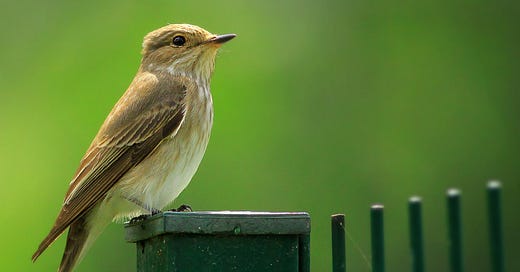Not so much a song as a succession of short squeaks, the sound of a spotted flycatcher is perhaps the subtlest of all our summer visitors.
They usually sing from an open branch, well above head height. The thin, tuneless notes are short and given in rapid but slightly irregular intervals.
They sound raspy, almost like a tiny nestling begging for food.
These subtle squeaks are easily missed in the presence of more musical neighbours.
The male sits quite upright as he sings. If he is facing in your direction, his pale chest and belly may give him away against a backdrop of greenery.
With a close view the marks on the breast can be seen. Although the bird’s called ‘spotted’, it’s only the young that appear so. Adults are more accurately described as streaky.
If he is turned away he’s harder to see, with a greyish back, whitish fringes to some of the lower feathers and a darker brown edge to the wings.
Males and females appear much alike. On looks alone, glimpsed briefly, they might easily go down as an unidentified Little Brown Job.
The ‘flycatcher’ part of their name is a more helpful clue to their identity, because it’s often their flight behaviour that attracts our attention.
While many species of perching birds have a go at catching flies on the wing, few make it an art form.
Spotted flycatchers like to pick an open spot at the edge of a clearing in woodland - or, if you’re very lucky, in your garden - and make little sorties from a strategically placed branch or rooftop.
Often this will be where midges or other tiny bugs are swarming, and the flycatcher can nip out, grab a few and return to where it was.
As with many of our insect-eating summer visitors, spotted flycatchers have declined precipitously, with around 9/10 birds disappearing between the late 1960s and the 2010s. This is is especially stark in the south-east of England, where many villages and parks are no longer home to any of these formerly common birds, save perhaps a few birds passing through in spring or autumn.
They are to be found more reliably in the west and the north, and knowing their squeaky signature tune lifts our chances of seeing one, and perhaps enjoying them at work, somewhere in the dappled shade of the summer’s leaves.
Next week: Corn Bunting
Credits:
Image by Pixabay user babilkulesi




